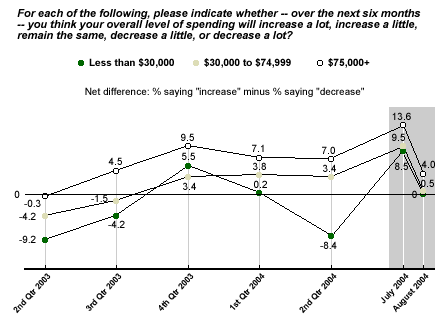Gallup's Aug. 9-11 poll* indicates that consumer confidence measures declined again in mid-August, reaffirming the downward trend in consumer and investor optimism. The decline first surfaced with the July drop in the UBS/Gallup Index of Investor Optimism, and the downtick in Gallup's July 30-Aug. 1 consumer confidence measures accentuated it.
More importantly, consumer spending intentions fell sharply this month, nearly erasing their July gains. This drop squares with the weaker-than-expected improvement in July retail sales and does not bode well for the remainder of the back-to-school sales period.
Not only did spending intentions decline across all income groups in early August, but the differences between the spending intentions of upper- and lower-income consumers also narrowed substantially, suggesting that consumer spending will be weaker than hoped across the retail industry in the weeks ahead.
Consumer Spending Intentions
During the second quarter of 2004, consumer spending intentions (the percentage of consumers planning to increase their level of spending over the next six months minus the percentage planning to decrease their spending) remained virtually unchanged from the first quarter among the top two income groups (those with annual household incomes between $30,000 and $75,000, and those with incomes of $75,000 or more). However, the spending plans of consumers in the lowest household income category (less than $30,000) continued to plunge in the second quarter following a sharp first quarter decline.
Although monthly spending intentions data are somewhat less reliable than quarterly data, monthly spending intentions showed a strong increase across all income groups in July. Spending intentions among the lowest-income consumers improved significantly.
But in mid-August, spending intentions among all three income groups decreased, by about equal amounts. Overall, the intentions of consumers in the upper two income groups are lower than they were during the second quarter. While the spending plans of those with household incomes of less than $30,000 remain weak, they are still better now than they were during the second quarter.

Bottom Line
After increasing interest rates a week ago, the Federal Open Market Committee (FOMC) noted, "In recent months, output growth has moderated and the pace of improvement in labor market conditions has slowed. This softness likely owes importantly to the substantial rise in energy prices. The economy nevertheless appears poised to resume a stronger pace of expansion going forward."
Maybe the FOMC knows something the rest of us don't. Gas prices continue to decline at the pump, even though the price of oil continues to surge. If this seemingly illogical trend were to continue and expand, then declining gas prices could help stimulate consumer spending in the weeks and months ahead.
But barring such an unexpected turn of events, consumer confidence and spending intentions, combined with the high price of oil, suggest that American retailers will have disappointing back-to-school sales in the coming weeks. Even upper-end retailers are likely to fall short of what they had hoped for a few weeks ago.
I believe that the "softness" the FOMC referred to in its recent statement will be more significant than expected, endangering the "stronger pace of expansion" that the FOMC forecast going forward.
*Results are based on telephone interviews with 1,017 national adults, aged 18 and older, conducted Aug. 9-11, 2004. For results based on the total sample of national adults, one can say with 95% confidence that the margin of sampling error is ±3 percentage points.
